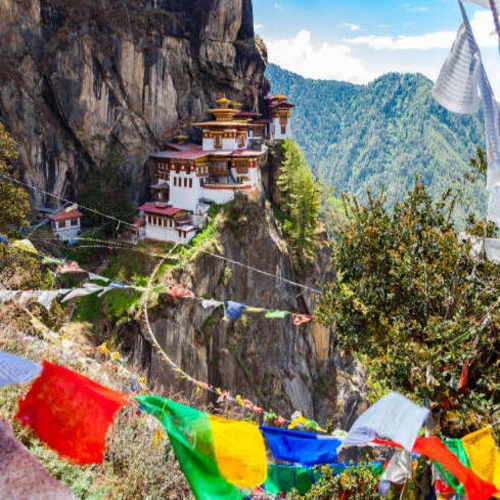Information on Travelling to Bhutan
When to Visit Bhutan?
Spring (March, April, May) and autumn (September, October, November) are the best seasons to visit Bhutan. However, December and Feb are still recommended. The major cultural festivals are held during these seasons, and the fine weather makes it an ideal time for trekking and traveling throughout the country and viewing the high mountain peaks. The rainy season falls in June – August, with rainfall averaging about 0.5m (1.5ft). But still, people can make the trip.
Clothing in Bhutan
In October, November, December, January, and February, mornings and evenings will be cold. You will have to bring in warm clothes (thick overcoats not necessary). While February, March, April, May, June, July, August, and September, the days are warmer. June, July, and August will be a little wet, and some rain gear would be necessary. Due to the wide range of temperatures and climatic conditions, it is advisable to bring appropriate clothing. Sunglasses/spare glasses or contact lenses, pair of casual shoes, trekking boot if you choose Bhutan treks, washing kit, shaving kit, towel, hat, umbrella, camera, film and accessories, maps, insect repellent, hand cream, small sewing kit & safety pins, torch or flashlight with spare batteries, mirror, sunscreen cream, lip salve or soluble aspirin, antiseptic cream, preparation for the relief of sunburn. You may not be tuned to the Asian drugs, so it is always better to bring your own brand.
Accommodation in Bhutan
offers generally modest but clean hotels. There are none of the chain hotels in Bhutan, although a couple of high-end resorts have been opened in some districts ( UMa Paro and Taj). Earthbound expeditions and its agents put you up in the best available hotels that are classified and approved by the Royal Government as class A. Visitors are advised not to expect luxury or five-star hotel services. Bhutan’s local hospitality is, however, an insight into a society where tourism may be a new venture but where visitors are greeted with true warmth and friendship. Only about 22,000 tourist visit Bhutan a year. Generally, tourist facilities and services are good in western Bhutan, but the quality of service and facilities decreases the further east we go. This is because tourism is less developed in more remote areas.
Transportation in Bhutan
Expect some treks; most of the time, we explore Bhutan by drive. We arrange comfortable passenger coaster buses for groups of seven visitors or more. You will also be traveling comfortably throughout the country in six-seater Japanese hi-ace buses. Smaller groups of one to two passengers will discover the country in luxury SUVs. Meals in Bhutan A variety of meals are available in most hotels – the most popular being Indian, Chinese, and the more common continental food. Don’t forget the try Bhutanese Chilly and Cheese with brown Rice! Nonvegetarian dishes are generally available in most parts of Bhutan – pork, beef, chicken, and fish. The best advice is to ask the hotel and restaurant to recommend what is fresh and in season.
Guides in Bhutan
In our Bhutan tours, licensed Bhutanese travel guides will introduce you to the many facets of this interesting country. The English-speaking guides undergo regular training and, where required, specialized guides will lead you on bird watching, botany, or other special tours.
Tipping
Although the system of “give and take” is always there in Bhutanese tradition, tipping is not compulsory. But if you would like to appreciate the services of our guides, drivers and service staff, you may tip them according to your will.
Money in Bhutan
Bhutan money is called NU (Ngultrum). 1US$ = 62NU (Ngultrum). Ngultrum is the currency of Bhutan. It is equivalent to the Indian rupee, which is widely accepted throughout Bhutan. It's possible to get Ngultrum at the Paro airport, Bhutan National Bank, and the Bank of Bhutan. It is also available at all hotels, but the exchange rate is slightly higher than banks. You are advised to bring in traveler’s checks or cash dollars, which are widely accepted. There are no credit or debit card ATMs in Bhutan except for the locals. For convenience, it is preferable to have traveler's cheques and/or cash dollars.
Bhutan Tourism Policy
The tourism industry in Bhutan is founded on the principle of sustainability, meaning that tourism must be environmentally and ecologically friendly, socially and culturally acceptable, and economically viable. For this reason, the number of tourists visiting Bhutan is kept to an environmentally manageable level through Government regulated tourist tariff. It is mandatory to have your trips organized through any one of the registered tour operators in Bhutan, as no other missions or embassies will arrange your travel to Bhutan. Bhutanese missions or embassies will not arrange your travel or tourist visa to Bhutan. Also the Govt. has fixed the rate of tourists, how much they should pay each night.
Photography in Bhutan
Bhutan is a photographer’s paradise, perhaps one of the most photogenic places in the world. The landscape, nature, and architecture are amazing. People are generally happy to pose for pictures but do ask before you do so if you are focusing on one person. Photography is not permitted inside Dzongs, monasteries, and temples as they are considered living institutions. You could use your video camera to record your events during the tours (except in those restricted places mentioned), but there is a set of rules for commercial filming. It is advisable to bring your photographic equipment and needs. Traveling Insurance for Bhutan for Trekking and Tour Most treks and tour in Bhutan goes to a height where most of the people show signs of altitude sickness, but so far, we have had no single case casualty. Our guides are well-trained in mountain sickness, medicine, and care. Our trekking staff can handle the situation professionally and effectively.
The cost that we provide does not include insurance of any kind, and you will have to get it insured from your country of origin before you come for trekking in Bhutan.
